Introduction
Meditating can change your mind – that’s the opinion of some experts.
初めに
瞑想で心の持ち方が変えることができると言う専門家がいます。本当でしょうか。
 One thing that millions of people around the world do is meditate to relax and that’s the subject of our programme. We’ll be looking at experiments by scientists in the US into the Buddhist practice of meditation. We’ll find out how Tibetan monks use meditation techniques to focus better and manage their emotions.
One thing that millions of people around the world do is meditate to relax and that’s the subject of our programme. We’ll be looking at experiments by scientists in the US into the Buddhist practice of meditation. We’ll find out how Tibetan monks use meditation techniques to focus better and manage their emotions.
世界中の何百万人もの人々がリラックスするために瞑想をしています。今回この番組が採り上げるテーマがこれです。番組では、アメリカの科学者たちの実験をみていきます。仏教徒が実際に瞑想することを題材にして、チベットの僧侶がどのように瞑想のテクニックを使って集中力を高め、感情をコントロールしているのかを探っていきます。
After all, Buddhist meditation is an ancient practice – even science, according to some. Tibetan Buddhism, as embodied by the Dalai Lama, is what many people think of when you mention meditation.
とどのつまり、仏教の瞑想は古代から実践されてきました。科学であるというひともいます。チベット仏教は、ダライラマによって具現化されたように、「瞑想」と口にしたときに、多くのひとの頭に浮かぶものです。
Professor Richard Davidson of the Center for Healthy Minds spoke about his remarkable scientific experiment which proved for the first time that meditation can actually change the brain.
「健康な心の研究所」のリチャードデビッドソン教授が、自身が行った特筆すべき科学的実験について話しています。この実験によって、瞑想が実際に脳を変えられることを初めて証明したのです。
Richard Davidson
When I first met His Holiness the Dalai Lama it was 1972. He challenged me, he said, ‘I understand that you’ve been using tools of modern neuroscience to study anxiety and depression. Why can’t you use those same tools to study kindness and to study compassion?’
リチャードデビッドソン
私が初めてダライ・ラマ法王にお会いしたのは1972年のことでした。彼はこう言って私に挑んできました。「あなたが不安やうつ病を研究するために現代の神経科学のツールを使用してきたことを存じています。それではなぜ同じツールを使って優しさや思いやりについて研究できないのですか。」
In his test, Buddhist monks sent out loving thoughts to everyone equally – to friends, enemies and strangers as well as to themselves. Compassionate thoughts such as ‘May you be happy and peaceful’, ‘May you not suffer’. And the results were astonishing!
What did they show? 何を見せてくれたのでしょう。
Very high levels of gamma oscillations – now that’s brain waves showing increased connections between different parts of the brain. This is what you or I might experience as a flash of insight – a moment of sudden understanding and clarity. For us, it might last less than a second. But for these experienced Buddhist monks, the gamma waves lasted minutes! Furthermore, as Richard Davidson explains, brain changes as a result of meditation can be long lasting.
非常に高いレベルのガンマ線の波動です。脳のさまざまな部分の接続を倍加する脳波のことです。これは、あなたも私も洞察力の閃きとして経験するもので、突然、一瞬にして理解と明晰が達成されます。それは1秒にも満たない短い時間かもしれません。しかし、これらの経験豊富な僧侶では、ガンマ波は数分続きました。さらに、教授が説明するように、瞑想の結果としての脳の変化は長続きするようになるのです。
Richard Davidson
There is no question at this point in time based upon the current science that has been conducted over the last 10 years, that meditation can change the brain in enduring ways; and the circuits that are involved are multiple, but they include circuits that are important for regulating attention and regulating emotion.
リチャード・デイビッドソン
現時点では、過去10年以上にわたって行われてきた現在の科学に基づいて、瞑想が長続きする方法で脳を変えられることに疑問はありません。また脳の回路についても同じことが言えます。関係する回路はいくつかありますが、注意力や感情を司る重要な回路が含まれています。
So, this was proof of neuroplasticity – our brain’s ability to change in response to conscious effort. In other words, the meditating monks were intentionally remoulding their minds in more positive ways! And this was possible because the brain circuits – different parts of the brain responsible for different functions – start talking to each other in new ways that created enduring – meaning long-lasting – changes.
The meditators gained insight into how their minds work. They were more focused and emotionally balanced and less likely to get upset.
瞑想者は、自分の心がどのように働くかについての洞察を得ました。集中の度合いが増して、感情のバランスがとれていて、気持ちが動揺する可能性が低くなっていたのです。



最近のコメント